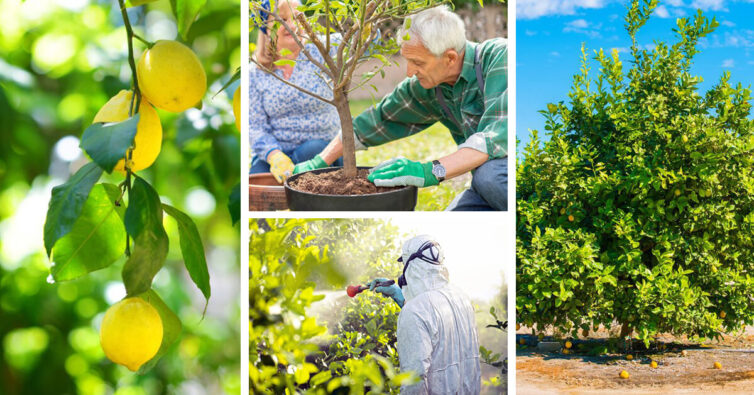Seeing lemon trees in your travels has a wistful appeal. It requires tropical and subtropical (USDA Zones 8-11). If you live in one of those zones, you could have a lovely lemon tree year-round. Better still, it’s self-pollinating, so you can get fruit even if you only want one tree. For lemon tree care, however, you need a little patience. It can take 4 years until your tree produces fruit.
Landscaping with Lemon Trees
Get to know your lemon tree’s needs before you plant it and start growing. The tree requires being 20 feet away from building structures or other trees. It’s important to create your plan. Crowded lemon trees become more susceptible to disease and pests.
In blossom, the lemon tree’s flowers travel lightly on the winds. They’re dainty white and purple flowers growing in clusters. This plant has its own defensive system – thorns on tree twigs.
Toxicity: You may love lemons, but unfortunately, lemons don’t love pets. Keep them clear of the tree if they wander in your yard. Both the fruit and the roots contain oils that cause depression, diarrhea, vomiting, and sometimes dermatitis.
Adventures in Lemon Tree Care
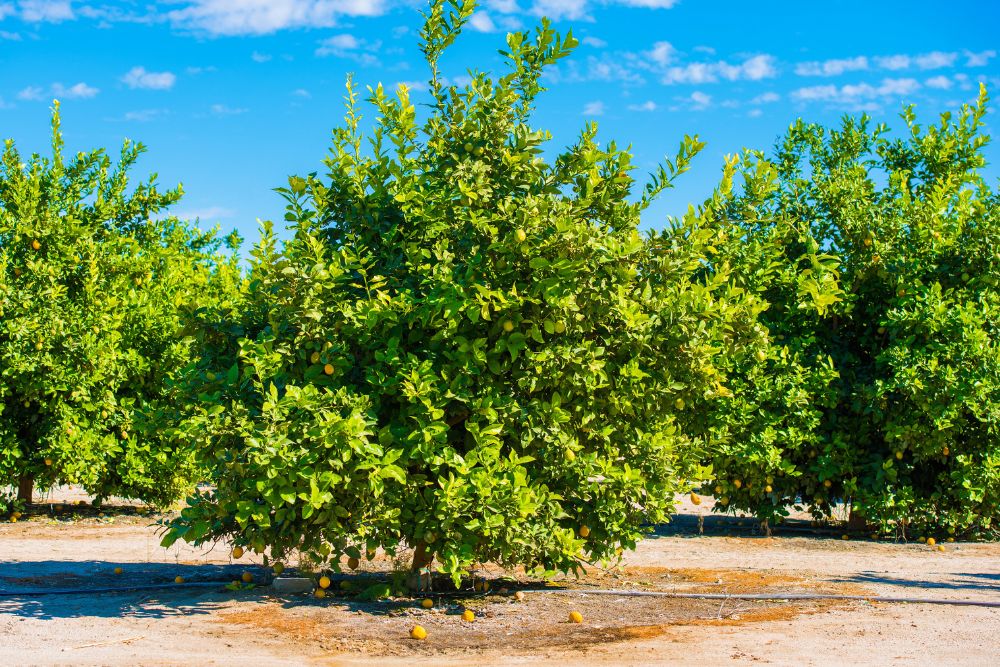
If you want a healthy lemon tree, the primary necessity in care boils down to location and a little panning. Never put your lemon tree in the ground before the danger of frost is over. You want your plant to have a full, warm season to establish itself.
Then there’s positioning. Look for an area that drains well naturally. If you can figure out a place where it grows safely away from wind, that’s best. The southwestern side of the house is one idea because it acts as a windbreaker while neatly protecting the plant from freezes.
Before you dig, remember lemon trees can be as high as 20 feet and 15 feet wide. Give it a good berth. Make your hole twice as wide and deep as the root ball. If your tree has binding on its roots, loosen it and let the roots breathe. Space helps the roots seek the nutrients they need.
You’ll be glad to know that among citrus trees, lemon stands out as one of the easiest to grow from cuttings. You’ll need a semi-hardwood cutting. Take it during spring and early summer, the active growth season. You’ll need a piece about 5 inches long. Avoid any area producing flowers or fruit. Stick to new growth.
Remove two sets of leaves from the bottom and dip the stick into hormone-rooting powder. Have a 1-gallon container prepared with well-draining media. Place the cutting in the center. You can put a plastic bag over the pot to improve humidity.
Set the container in a well-lit area and mist it periodically. After two months, there should be roots starting beneath the soil. Tug gently at the plant. If it resists, you have roots. Now all that remains is taking care of it until spring, when you move it into your yard.
Lemon Tree Needs
There are five basic needs for nearly every plant.
- Fertilizer: Lemon trees are high-energy plants. They need an NPK fertilizer (nitrogen, phosphorus, potassium) for healthy growth, including fruit production. If the tree’s yellow, it probably needs other minerals like zinc and iron.
- Light: Lemon trees are sun worshippers. They need at least eight hours daily of full sun.
- Soil: You need medium-textured soil with some acidity. Add a little mulch to help deter pooling water.
- Temperature & Humidity: In their natural habitat, lemon trees have warmth and humidity. Cold weather isn’t good for them. They thrive in temperatures between 75-85 °F when the humidity hovers around 50%. If you know that inclement weather is coming, and you can move the tree outdoors, do so.
- Water: For a successful harvest, your tree likes moderate rainfall. If the weather cooperates, you may not need to water frequently. The exception is when a tree is establishing roots. Then water 1-2 times weekly.
Lemon Tree History: Lemon trees appeared in southern Italy around 200 CE (if not earlier). The fruit then moved into Egypt (700 CE). Throughout the Mediterranean region, the distribution of lemons was common (1,000-1150 CE). In China, cultivation began around 750 CE and continued until 1297. In the late 1400s, lemon trees came to St. Augustine, FL. It wasn’t until the Mid-1700s, however, that lemons arrived in California.
Picking Lemons: Which Tree is Right for Your Home?
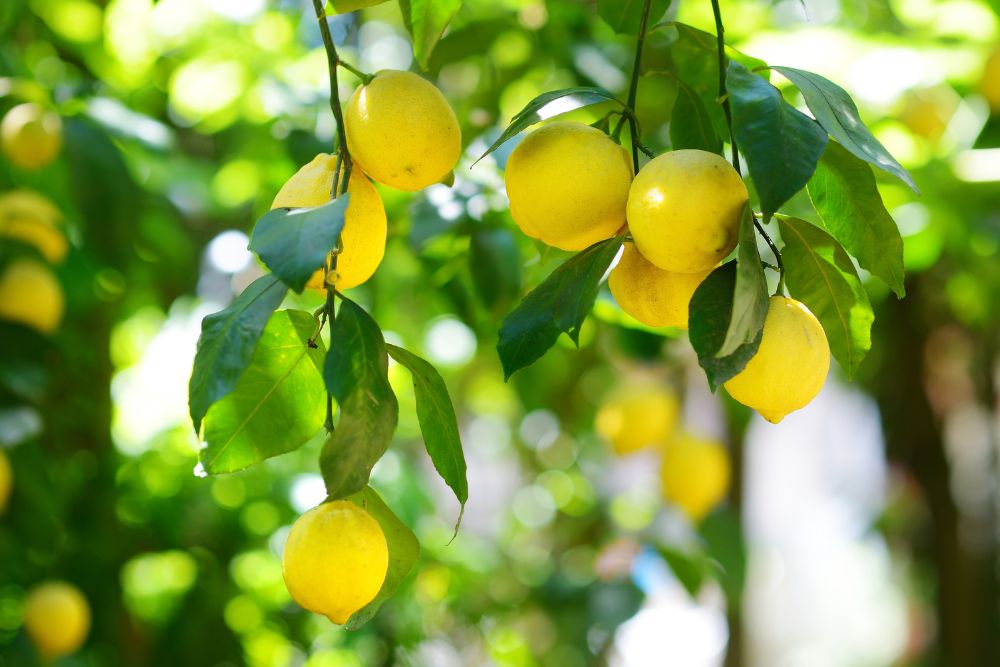
You might think a lemon is a lemon is a lemon! But there are different types of lemon trees grown residentially.
- Bearrs: The first seeding of this plant happened in 1892 in Bearrs’ Grove, Florida. The advantage of this tree is that it is nearly bereft of any thorns. These lemons are super juicy and have few seeds. The peel becomes lemon oil.
- Eureka: When you’re shopping for lemon trees, this is one you’ll find in many stores. It is by far the most popular homegrown variety. It yields a prolific harvest year-round. The Eureka tree takes 3 years to mature. Development of the first Eureka seedling was in Los Angeles, CA, in 1858.
- Lisbon: Lisbon yields a low-seed fruit that’s very juicy. The main harvest from Lisbon comes in winter, even though they produce fruit all year long. Very cold sensitive.
- Meyers: Less tangy than the previous three here, Meyer Lemons are a hybrid of a lemon and an orange partnership that worked out wonderfully. Meyers Lemons have a higher cold tolerance. When grown in a pot, its size adjusts. Dwarf Meyers grow 8 feet tall, while full-sized ones grow 10 feet tall.
How to Harvest Your Lemon Tree: Once the flowers develop into fruit, you still have to wait months for maturity. Leave them in place. Once off the tree, citrus will not ripen further. Take a cue from the fruit’s size. A mature lemon is 2-3 inches in diameter. Once ripe, the lemon will remain good until winter if left in place. All fruit should be harvested before spring blossoms appear.
Lemon trees fully mature at 5 to 6 years of age. After that, they can yield as many as 800 fruits a year.
Watering Techniques
The approach to watering your lemon tree depends on the climate conditions. Has it been humid? If so, water loss slows. Then too, there’s the side of the pot. The smaller the pot, the faster it dries out. If you’re in a windy area, the airflow can reduce moisture in the leaves.
Every houseplant has specific needs. It’s your job to get to know your plant based on environmental factors that may speed up or slow the amount of water you give your tree. The easiest check is hands-on. Put your finger in the soil. If the first two inches are dry, you are ok to water.
Look at the branches of your lemon tree. Where they end is the place you should water on the ground. Give them a good soaking. If the rainfall is average, applying water once or twice a week should be fine. You’ll know the tree needs more water if the leaves start curling and become crispy.
The mature fruit of a lemon tree is usually light green and measures 2 inches in diameter. After they’re picked, leave the lemons to cure. This isn’t a fancy process. Just put the fruit out at room temperature until the rinds turn yellow.
At this point you can use various approaches to storage. Lemons can hang out in the crisper for a month or more. Second is the water technique. You put the lemons in a food storage bag or jar, cover them with water, and refrigerate. They’ll last for about three months.
At room temperature, leave them in a mesh or paper bag (never plastic). Plastic bags trap moisture that could start rotting the lemons. The other bags give lemons a shelf life of about one month. Or freeze them whole (lasting four months). The only issue with freezing is that the lemons become mushy as they defrost. Nonetheless, they’re still juicy.
Potting and Repotting Lemon Trees
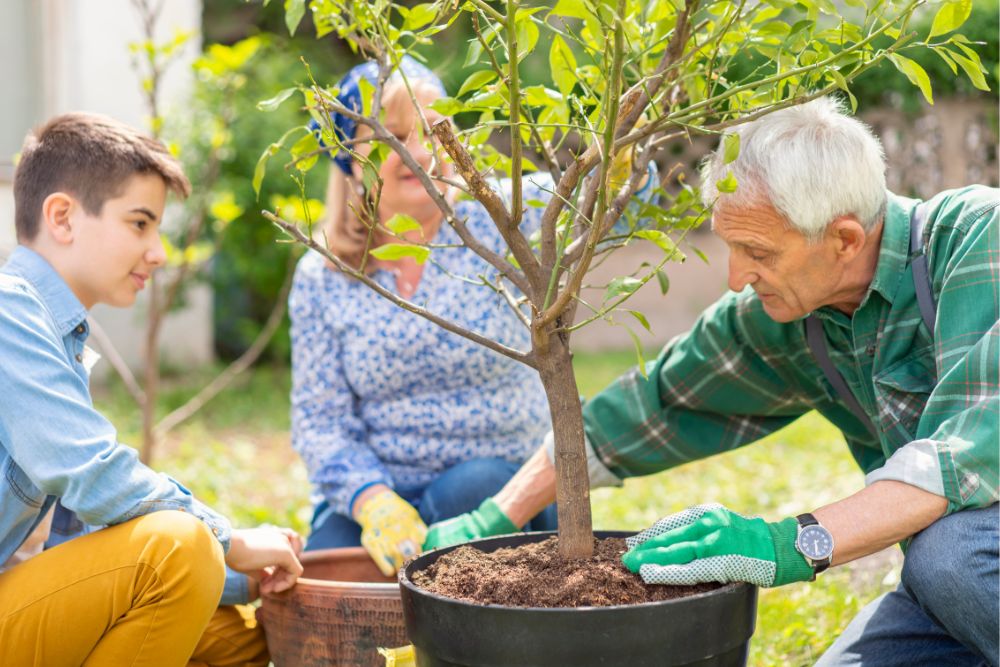
Setting your lemon tree up in a pot has two advantages. You can move it to different spots in the yard, and you can move it indoors to protect it when the weather cools.
Start with a young tree, about 15 inches tall. Buy a five-gallon container, with drainage holes, for it. Fill the pot halfway with citrus potting mixture.
Remove the tree from the greenhouse container. Fluff the roots so they’re not matted. Place the tree into the pot and start filling it in with more potting mixture. Fill it until you reach the crown of the roots. Water the lemon tree right away. It’s worth noting that your potted lemon needs more frequent watering than those planted in your yard.
Repotting (transplanting) is pretty much the same. You remove the tree from the old pot and gently loosen the roots. Take your time. They can be weak.
Fill the new container halfway, put the tree within, and fill in the soil around the tree.
Moving the Lemon Tree Indoors
When you know the weather is turning, bring the lemon tree indoors. You need a bright sunny spot for it, away from heating vents. Remove new growth at the base of the tree, and prune it regularly.
Two Fruits in One: The lemon is actually a cross-breed between sour oranges and citron. They come under the classification of heseperidia, which is, strictly speaking, a kind of berry! You will get about three tablespoons of juice from each fruit. In terms of lifespan, most lemon trees live 50 years, but with excellent care, they can live to 100.
Pruning and Maintenance
If you want improved fruit growth, prune along the lateral branches. Even if you’re just trimming for aesthetics, shape for a wide canopy. If you notice lemon spots or dead wood, prune those off.
When trees are young, pruning encourages a strong branch structure. As the tree grows, you have a fantastic opportunity to create a dome shape so successful for production. Keep the mature tree maintained at 8 feet high and 12 feet wide for the best health. You can hand prune small branches and leaves to open the underside of the canopy to the sun. On the other hand, excessive pruning on the exterior of the canopy may result in fewer lemons.
China, Egypt, Rome: In Egypt, folklore claimed eating lemons protected people from poison. In China, come spring, they favored lemon trees as gifts. The more lemons on the tree, the luckier it is. In Rome, it was customary for only people of means to use lemon trees on their property as an emblem of wealth.
Lemon Tree Blooming and Resting Periods
The resting period for Lemon trees is throughout the winter months. They don’t go completely dormant, but they do still need some water. You can also reduce your watering cycle to about once every three weeks. Don’t be surprised if the tree drops leaves at this time. It’s perfectly normal. Lemon Trees are very sensitive to cool weather.
During the spring, you should see buds appear. They’re petite, only ¼” long. Slowly the buds turn green just prior to opening. If the buds are black or brown, your lemon tree may be dead.
Hindu tradition teaches that lemon trees and houses are perfectly suited for each other. The lemon tree protects the house from negativity while promoting peace between all that live there. If you travel and ever see a lemon hanging from the front of an establishment or home, there’s bad juju afoot, and the lemon has work to do.
Common Lemon Tree Pests and Diseases
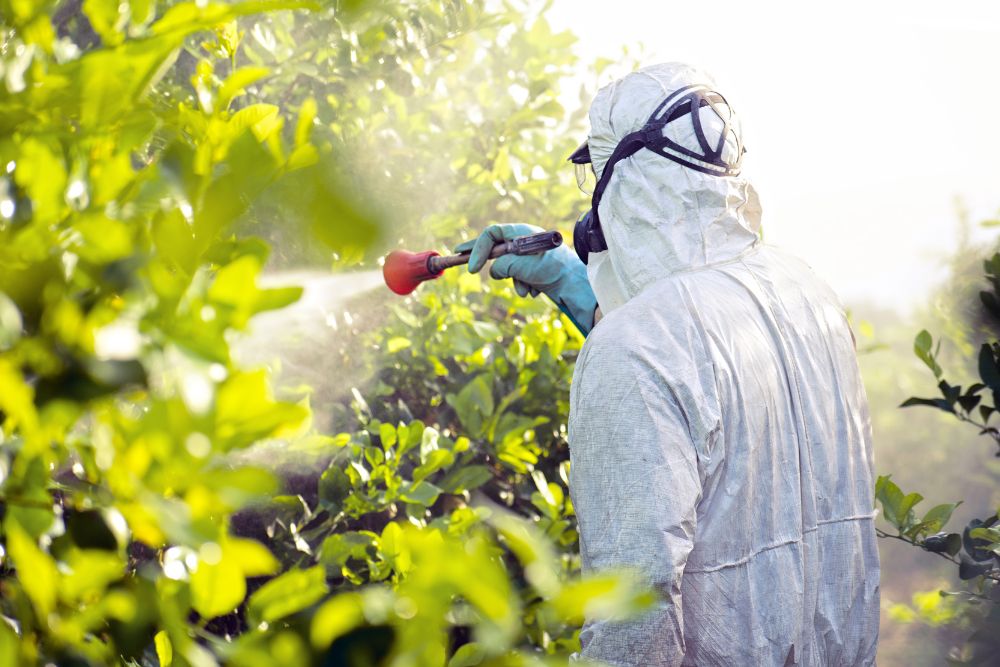
Citrus is notorious for attracting insects, ants being among them. While they alone are pesky, ants often carry other insects up the tree with them. Those insects start snacking. Next, the ant comes up the tree, taps on the infiltrator, and receives honeydew (scale & aphid). Ants will move their herd of cooperative bugs from garden to garden.
If you see ants making a home in the soil of your tree, it’s time for action. Set 3 pinches of borax with Mountain Dew in the bottle lid. Place the cap about 2 feet away from the tree. If you see tons of ants around your trap, don’t use so much borax. You want them to return to the colony.
Scale appears as crusty bumps on the tree. Spider mites leave behind little webs. Be on the lookout for whiteflies that lay their eggs under the leaves. Use Neem oil as a treatment.
Diseases
Citrus canker manifests as small spots on the tree’s leaves that slowly develop into a yellow halo. This requires fungicide. Melanose also requires fungicide. It looks like lesions that crack when you touch them. Greasy spot disease is another one to treat with fungicide. It looks like yellow spots that turn into brown blisters.
It’s postulated that the Hanging Gardens of Babylon houses Lemon Trees carried there from the India trade roots. Theophrastus, the father of botany, described lemon around 4 CE. Greek and Roman myths speak of lemons as dowry for Juno (Hero). The fruit was carefully hidden away and protected by the nymph Arethusa. When Hercules completed his 11th labor, the “golden apples” became a gift to humankind. The archaeological site in Pompei has frescos with lemons living among the trees there.
Troubleshooting Common Problems
Leaves look unhealthy: Disease and pests alike can make your plant look unhealthy. Start with the obvious. Is the plant getting enough water (or too much)? Has there been an odd turn in weather like a windstorm or hail? It may be worth having your soil checked to see if there are nutrient deficiencies.
Green veins on yellow leaves: There’s something awry with your soil. Specifically, it’s not acidic enough. You can get a soil additive to bring things back into balance.
No Fruits or Flowers: It’s normal for your tree to remain bare for up to five years. Some lemon trees only produce every other year. However, this is a good opportunity to look over your tree for potential other problems. If your lemon tree isn’t getting at least 8 hours of light daily, it affects growth and fruiting. Should your tree grow in a pot, move it to a better location.
Lemon Tree’s Long Roots: Archaeologists agree that humans propagated lemon trees as early as 4,000 years ago. Throughout Asia, we find praise for their medicinal properties. But Romans, Greeks, and Egyptians saw the potential, too. Lemon juice appeared in the healer’s kit for colds, insomnia, low energy, asthma, and fever.
[wp-faq-schema title=”Frequently Asked Questions About Outdoor Lemon Trees” accordion=1]Summary
As the song says, the lemon tree is indeed pretty with a sour fruit. If you live in the right area, you can grow lemon trees in your yard. Not only are they a visual accent that brightens up the whole landscape, but it’s also one that provides food!

